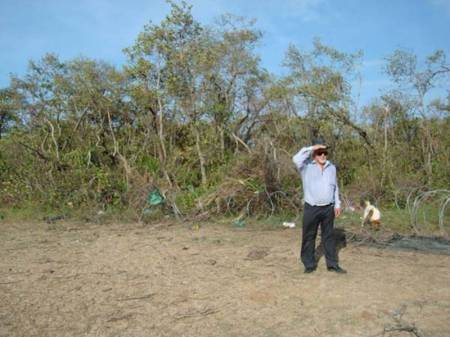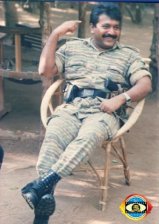Last hours of Velupillai Pirapāharan by Thuppahi`s blog
Michael Roberts
That the LTTE talaivar, Velupillai Pirapāharan, died a heroic death as a vīra maranam on the 18th or 19th May 2009 is now certain.[1]Though Tamil sources claim that he shot himself with his pistol when he and his troops were trapped in the mangrove swamps on the eastern shoreline of Nandhikadal lagoon, the weight of evidence suggests that he was hit by a bullet “traveling diagonally across VP’s skull, probably from left forehead to right rear of skull –[a bullet that was part of] either a rifle round, or a rifle-calibre round”(David Blacker, email to Roberts, 14 February 2012).
Whatever the verdict between these two alternative theories, there is little doubt that Pirapāharan adhered to the Tiger devotion to cause and the LTTE’s credo of being ready to die by gun or kuppi (cyanide pill). This fact should dispel the various strands of criticism levelled at Pirapāharan for not biting a cyanide capsule. A young Tamil friend voiced this complaint in conversation with me in mid-November 2012; and a senior government official named Ganesh (no less than the G. A. Jaffna) is said to have expressed “disappointment that Prabhakaran didn’t die fighting for his people” (Mahindapala 2009). In the expressions of diehard Sinhala extremists such as HLD Mahindapala, such an alleged fact becomes fodder for derisive commentary on the manner in which the Tiger supremo failed to live up to the principles imposed on his fighting personnel.
In an exchange in the vibrant web-journal TRANSCURRENTS, the knowledgeable editor, DBS Jeyaraj, responded on 26 November 2011 to a blogger’s comment with the note: “Prabhakaran fought to the end and then shot himself on 18th. Army recovered body hours later on 19th.” A similar verdict was recently conveyed to me by one of the civilians who was among the last cluster trapped at Vellamullavaikal in mid-May. He informed me that Pirapāharan placed his Glock pistol in his mouth and shot himself. Pirapāharan’s bodyguards thereupon hid his body and mostly proceeded to sacrifice their lives by their own hands in keeping with the ideals of the LTTE (Roberts 1996, 2005a, 2005b and 2006). But one or two bodyguards went back to the Last Redoubt at Mullivaikkal area and mingled with the civilians; when one was identified, he eventually led the SL Army troops to the area where the body was hidden.
 However, the facial photograph of the dead Pirapāharan does not support a right-handed action of this sort. In any event the opinion of a former soldier such as Blacker destroys this thesis. Responding to my direct query on this point on 14th February 2012, David Blacker went into riveting detail:
However, the facial photograph of the dead Pirapāharan does not support a right-handed action of this sort. In any event the opinion of a former soldier such as Blacker destroys this thesis. Responding to my direct query on this point on 14th February 2012, David Blacker went into riveting detail:
“Michael, DBSJ has steadfastly stuck to this story for a while now, but I disagree with him on VP’s death. I am attaching a picture of the latter post-mortem (which you have most likely seen before) for reference. That is most certainly not a self-inflicted bullet wound. A self-inflicted shot would have entered below the chin, through the mouth, or to the temple, if delivered to the head. And in pictures of VP in his underwear, there is no sign of a shot to the chest, which would be the most likely spot for a self-inflicted body shot.
Some might argue that the visible wound was inflicted post-mortem to cover a fatal self-inflicted exit wound. But if VP had shot himself under the chin or through the mouth, the hydrostatic damage to his eyes would have been visible. They would have been blown out of their sockets or at the very least very bloodshot. There is no such sign.
Another argument is that the wound is from shrapnel, but there is no sign of his head or face having been hit by fragments other than the one that delivered the wound. While this is not impossible, it is unlikely, and anyway not in line with DBSJ’s theory of suicide.
Yet another story is that the wound is from an axe or mammoty, inflicted by a senior Army officer. This too is unlikely, given that there’s no bruising around the wound.
I have seen many gunshot wounds close up, and I believe this to be inflicted by a high-velocity bullet traveling diagonally across VP’s skull, probably from left forehead to right rear of skull. That would be either a rifle round, or a rifle-calibre round. The angle rules out self-infliction.
I have posted my view on DBSJ’s blog but he has not allowed the comment through. He has previously asked me for my opinion via email, and I have given it; but he has not changed his view. He has also refused to give detailed answers to queries on how VP died; nor has he written an “expose” on it; leading me to believe that he doesn’t know for sure, but has been told his version by a trusted source.”
 To those unfamiliar with warfare, let me stress that Pirapāharan would not have been shot as Pirapāharan. In contrast with snipers shooting at long range, in gunfights in jungle terrain good soldiers shoot at enemy bodies across the way in instinctive bursts without identifying officers or individuals. Pausing to identify is deadly for self and is bad soldiery. The information trickling in from friends of military men is that the army platoons simply ‘inundated’ the mangrove areas where the last Tiger units had taken refuge with concentrated volleys of automatic fire and the odd RPG round.
To those unfamiliar with warfare, let me stress that Pirapāharan would not have been shot as Pirapāharan. In contrast with snipers shooting at long range, in gunfights in jungle terrain good soldiers shoot at enemy bodies across the way in instinctive bursts without identifying officers or individuals. Pausing to identify is deadly for self and is bad soldiery. The information trickling in from friends of military men is that the army platoons simply ‘inundated’ the mangrove areas where the last Tiger units had taken refuge with concentrated volleys of automatic fire and the odd RPG round.
 SL Army troops trawling for bodies
SL Army troops trawling for bodies
 Mahindapala in the area of Pirapaharan’s Last Stand
Mahindapala in the area of Pirapaharan’s Last Stand
With access to the highest authorities HLD Mahindapala gained entry to the arena of thetalaivar’s last stand as well as the troops involved in this final set of gun-battles. His essay on the topic is mandatory reading for those interested in the debate because it provides details on the context (though one has to siphon off his disparagement and his gloating).
“Fierce fighting broke out on the evening of May 17th. According to Army sources, Prabhakaran, surrounded by his bodyguards, was moving across the waters, shifting among the mangroves. The fighting went on till 3.30 a.m. on May 18th. Sgt. Banda, who was in one of the islets, encountered fierce attacks. He called for reinforcements. They suspected that Prabhakaran must be among the Tiger cadres moving across. With the arrival of new reinforcements fighting went on till 5.30 am.
Col. G. V. Ravipriya told me that nearly 100 terrorists had surrounded them [Sgt Banda’s unit].” He added: “I sent another team to assist them. The Tigers then escaped to a mangrove in the left of the island.”
Col. Ravipriya then planned to clear the mangrove at dawn. Before that he brought down artillery, armoured tanks, infantry mortars and RPGs. From this base he kept firing till 11 a.m. of May 18th. Col Ravipriya then sent commandos to clear the mangroves. Over 100 bodies were found there. Clearing was over by 6.30 p.m. It was getting dark. Clearing began next morning at 7.30 a.m. Suddenly, they were confronted by a group of Tigers. The Forces asked for help and more troops were sent by Col. Ravipriya.
Clearing began again on the 19th. Firing had stopped. The Forces started collecting bodies again around 9.30 a.m. Sgt. Muthu Banda then cried that he found a body similar to that of Prabhakaran. He was asked to bring the body out of the mangrove bushes. Brig. Commander Col Gamage was the first to identify the body. He found the identity tag: 001.
Nobody knows who fired the fatal bullet. It seems to be a gun shot fired within a range of about 10 metres [emphasis added by Roberts].
 Mangrove swamp thicket of the type where the last gunfights occurred
Mangrove swamp thicket of the type where the last gunfights occurred
This evaluation must be supplemented by a study of photographs of the mangrove swamp terrain. It is with attention to such details and this context that one must review Blacker’s considered verdict and ask medical personnel familiar with war wounds whether the image of Pirapaharan’s visage-in-death supports Blacker’s argument and is consistent with a relatively close range shot of a rifle bullet (itself, presumably, part of a burst).
 Karuna Amman and Daya Master identify Pirapāharan
Karuna Amman and Daya Master identify Pirapāharan
Answering my query, Dr Susiri Weerasekera cautiously noted that the killer-bullet is very “unlikely to be [from] a pistol. … Far more likely blasted off from a distance.” The image displayed by the GSL Army, he stresses, is “after a stitching-up which hides the damage within.







